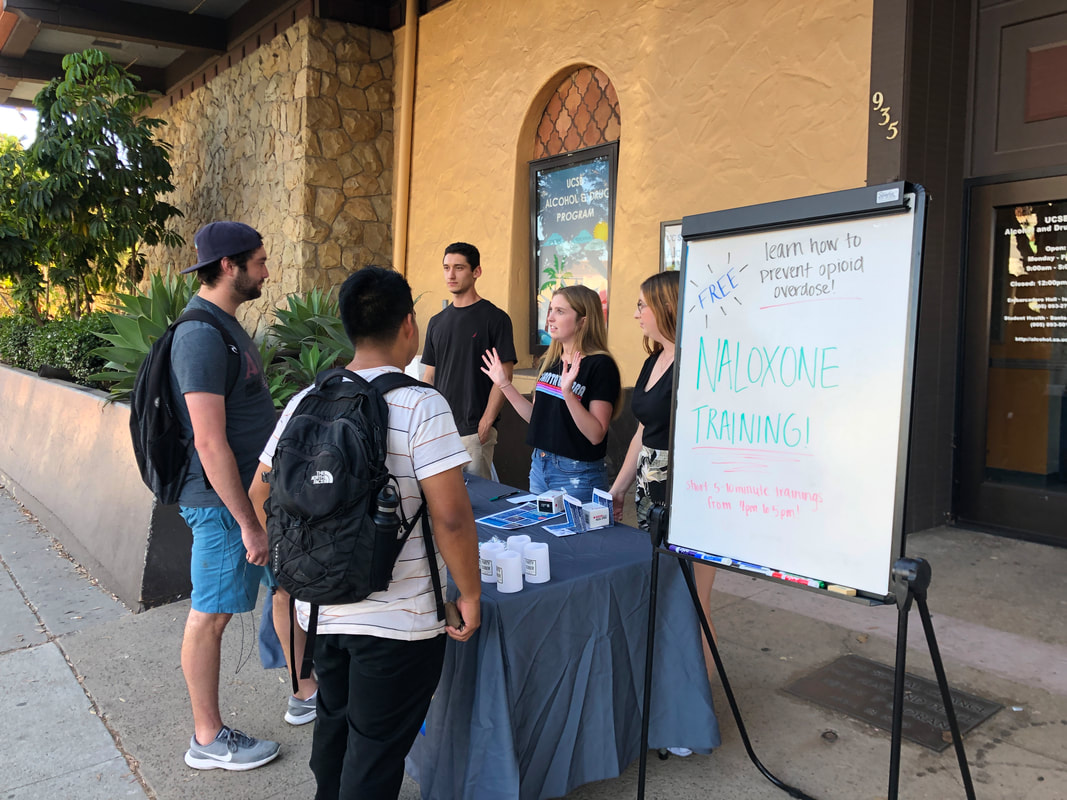
UC Santa Barbara has been distributing naloxone to students through our collegiate recovery program, Gauchos for Recovery (GFR), since April 2019. We have given out over 200 free naloxone kits to students and community members since the program’s inception, and have given 50 to our UC police department. At least one of the kits we distributed was used to reverse an overdose, and there are likely more that we are not aware of. Many lives have been saved by naloxone administered by law enforcement and emergency personnel in our student community since they began carrying it several years ago.
How we practice harm reduction at UCSB
In addition to regular community training, Gauchos for Recovery student interns provide peer-to-peer naloxone training and distribution. Students can come to intern office hours in the recovery lounge on a drop-in basis and request naloxone anonymously. Peer interns provide brief training and give the student a naloxone kit.
We are also working with our local syringe exchange program to distribute fentanyl testing strips, clean syringes, and other safety supplies for opioid users in our student community.
Peer-based recovery services
Peer-based services are consistently shown to be an effective method of reaching students on a variety of issues. At UCSB, this is demonstrated by the success of the Recovery Peer Intern outreach program that has been in existence since 2012, wherein interns reach out directly to other students considering recovery to share their experiences and connect them with campus recovery supports.
Our peer interns provided outreach to over 100 students in the last three years. They create an environment of non-judgment and trust, and their compassionate attitude reduces the fear of stigma from those seeking support. Our recovery peers have unique experience and expertise that allows them to connect with other students in an effective way. Peers can provide naloxone to students without fearing judgment, becoming known to the University as a drug user, or having this information documented in medical or student records. Students seeking naloxone through our peer-to-peer program do not have to come in contact with any staff nor are they required to provide any identifying information.
Allowing Recovery Peer Interns to distribute naloxone also creates an important opportunity for students who may be using opiates, or who have friends or loved ones who use opiates, to receive information about recovery support, which they would not necessarily get through a pharmacy, doctor, or other naloxone access point. This can include professional counseling through our Alcohol and Drug Program licensed clinicians, Gauchos for Recovery meetings, 12-step programs (including Al-Anon), and other support services.
It is important to note that our peers do not have an agenda of promoting abstinence-based recovery to students seeking naloxone. Naloxone is a harm-reduction tool, and our aim is to keep students safe and reduce the risk of overdose death. If the student expresses interest in any degree of recovery support, whether or not they are interested in abstinence, the peer will connect them with the appropriate resources. Each student’s kit includes an informational handout about opioids, overdose prevention, and how to use naloxone. It also includes a business card with the time and day of the Gauchos for Recovery weekly open recovery meeting, the peer intern office hours, and the website to get more information.
Some students requesting naloxone are not regular opioid users, but are planning to experiment. Some are obtaining the medication to prevent overdose by their peers.. Regardless of whether or not they have a substance use disorder, any opportunity we have to increase awareness of recovery supports on campus is a way to eventually reach those students who need us.
Collegiate recovery and harm reduction
Collegiate recovery and harm-reduction tools are not antithetical to one another. Abstinence is one form of harm reduction and is the best way to reduce harm for many people, but not for everyone. Some people may have abstinence as a goal, but are not ready to take that step. Some may not have a goal of abstinence. Showing compassion and providing the tools to be safe can offer an entry point to making positive change. Whether that ends up being abstinence or not is not for anyone but the individual to decide.
Collegiate recovery is in many ways a social justice movement. We aim to provide accessibility and support to students in recovery seeking a higher education who may not otherwise be able to attend or complete college. We aim to remove barriers to achieving personal, academic, and professional goals. All of us in abstinence-based recovery from an SUD were active substance users at one time, and at some point we all received help from someone who didn’t judge us for who we were at that exact moment. Students who choose abstinence-based recovery need specific supports to maintain that way of life, and having programs and spaces exclusively for those students is essential. But we can also be there for the students who may not be ready for that, or who simply want to be empowered to save lives in their community. There is enough room for everyone.